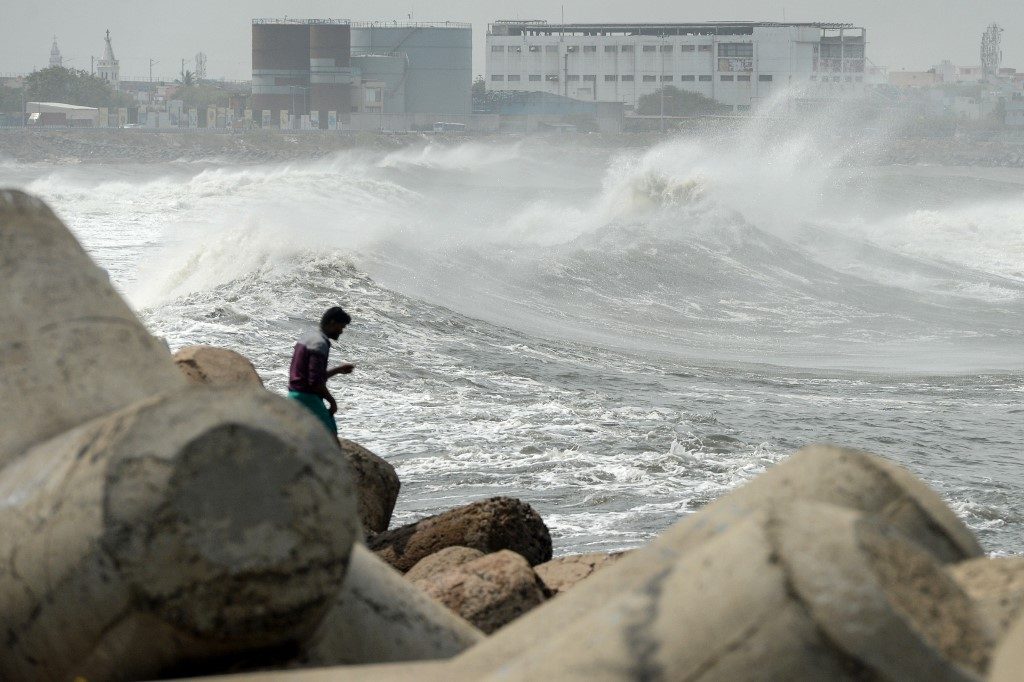SUMMARY
This is AI generated summarization, which may have errors. For context, always refer to the full article.

KHULNA, Bangladesh – The Bay of Bengal’s fiercest cyclone this century was bearing down on millions of people in eastern India and Bangladesh on Wednesday, May 20, with forecasts of a potentially devastating and deadly storm surge.
Authorities have scrambled to stage mass evacuations away from the path of Amphan, which is only the second “super cyclone” to form in the northeastern Indian Ocean since records began.
But their efforts have been hampered by the need to follow strict precautions to prevent the spread of the coronavirus pandemic, with infection numbers still soaring in both countries.
Out at sea the vast weather system visible from space packed winds of up to 240 kilometers per hour (150 mph), the equivalent of a category 4 hurricane.
It was expected to ease slightly before crossing the coasts of the eastern Indian state of West Bengal and neighbouring Bangladesh after 0900 GMT.
But the storm could still be strong enough to “cause large-scale and extensive damage,” said the head of India’s weather office Mrutyunjay Mohapatra.
Along with “very heavy rainfall” the system was expected to result in a storm surge pushing the sea level several meters higher, his office said.
Storm surges can force a wall of water to cascade several kilometers inland, and are often responsible for massive loss of life during the most severe cyclones.
Regular victims
Bangladesh’s low-lying coast, home to 30 million people, and India’s east are regularly battered by cyclones that have claimed the lives of hundreds of thousands of people in recent decades.
The eastern Indian state of Odisha was hit by a super cyclone that left nearly 10,000 dead in 1999, 8 years after a typhoon, tornadoes, and flooding killed 139,000 in Bangladesh.
While the storms’ frequency and intensity have increased – a phenomenon blamed partly on climate change – deaths have fallen thanks to faster evacuations, better technology and more shelters.
But Bangladesh authorities still fear that Amphan will be the most powerful storm front since Cyclone Sidr devastated the country in 2007, killing about 3,500 people, and causing billions of dollars in damage.
The country has been feverishly working to bring 2.2 million people to safety, while West Bengal was relocating 300,000 others.
The Catholic Relief Services (CRS) aid group said people faced “an impossible choice” of braving the cyclone by staying put, or risking coronavirus infection in a shelter.
Authorities in both countries said that they were using extra shelter space to reduce crowding, while also making facemasks compulsory and providing extra soap and sanitizer.
“We are also keeping separate isolation rooms in the shelters for any infected patients,” Bangladesh’s junior disaster management minister Enamur Rahman told AFP.
Rohingya refugees
Although outside the predicted direct path of the storm, there are fears for the safety of almost a million Rohingya refugees from Myanmar in southeastern Bangladesh – most living in vast camps and housed in flimsy and makeshift shacks.
The first coronavirus cases were reported there last week, and by Tuesday there were 6 confirmed infections.
The UN said emergency items such as food, tarpaulins, and water purification tablets had been stockpiled, while authorities said the refugees would be moved to sturdier buildings like schools.
“Heavy rains, flooding, (and) the destruction of homes and farmland, will increase the likelihood of the virus spreading, particularly in densely populated areas like the refugee camps in Cox’s Bazar,” ActionAid said.
“It will also undoubtedly increase the number of lives and livelihoods already lost to this pandemic.” – Rappler.com
Add a comment
How does this make you feel?
There are no comments yet. Add your comment to start the conversation.